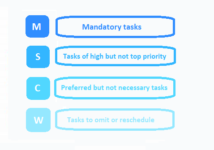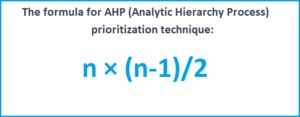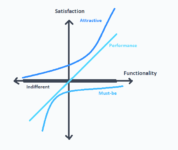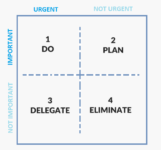Prioritization is among the must-have skills for business people regardless of their team and project’s size. In 2020, when COVID-19 forced most of us to do work planning in a remote environment, this skill gets to a new level:
Product people work in remote teams now. Not only does it require more self-discipline to stay productive, but it also leads to the necessity for trying even more prioritization techniques so that our projects would thrive.
Given that we will most likely continue the “work from home” and “work from anywhere” concepts in 2021, the need for stellar prioritization skills and tools grows. We need instruments that would help us set priorities for project tasks, objectives, and overall workflow.
The below powerful prioritization techniques are what can help deal with that. Each has its pros and cons, so consider those fitting your business most.
1) MoSCoW Prioritization Technique
A classic goes first: MoSCoW is among the most popular techniques in the business environment. It doesn’t require any calculations, being the most straightforward approach that saves time and promotes team collaboration.
MoSCoW is a part of the DSDM (Dynamic Systems Development Method) techniques. Key stakeholders use it to understand the significance of different initiatives.
This technique helps prioritize each task from the perspective of four categories:
- MUST (Mandatory tasks you can’t neglect. Otherwise, the whole sprint will most likely fail.)
- SHOULD (Tasks of high but not top priority. They don’t have much impact now, though you’ll need to implement them eventually.)
- COULD (Preferred but not necessary tasks. They are about small-scale improvements, which absence won’t harm the project.)
- WOULD or WON’T (Tasks that don’t match any current needs so that stakeholders can omit or reschedule them for the future.)
What makes the MoSCoW technique worth trying is its simplicity and operational friendliness. This method doesn’t require any in-depth calculations, is fast in implementing, and promotes employee engagement and mutual understanding between project managers and their teams. Since it has no strict time limits, MoSCoW allows for adjusting releases or feature deliveries on favorable terms.

2) Analytic Hierarchy Process (AHP)
Designed by the University of Pittsburgh’s Professor Thomas L. Saaty, this prioritization technique describes an entire framework for business decisions in many fields. Project managers organize complex decisions with math and psychology in mind here.
They divide a big goal into smaller sub-problems, evaluate each element, and build the prioritization hierarchy that way.
The AHP contains three parts:
- The ultimate goal (problem) stakeholders try to solve
- All the possible solutions (alternatives) to the problem
- The criteria they will use to judge every solution and its relation to the overall goal
Stakeholders compare the importance of criteria in pairs, then converting their evaluations of each alternative option into numbers. The more numbers a solution gets, the more priority it will have for implementation.
That’s what distinguishes this prioritization technique from other methods: It has quantifying capability, stated in the math formula.

Once the hierarchy is ready, managers use this formula to compare sub-problems to each other. N is for the number of requirements at each hierarchy level. Therefore, a project manager evaluates the relative importance of each element and prioritizes tasks accordingly.
3) Kano Model
This one comes from Japanese researcher Noriaki Kano, and it promotes prioritization based on levels of users’ satisfaction with a product. The technique rests on a questionnaire to learn users’ attitude to this or that feature (like, dislike, expect, neutral, etc.) Based on the results, stakeholders divide the product by criteria and prioritize processes and tasks in a team accordingly.
These criteria might be as follows:
- Must-be features of a product: A user considers them critical for a product to work.
- One-dimensional elements: They are not a must-have, but a user wants to see them in a product.
- Attractive features: Unexpected by users, but they admit they are nice-to-have.
- Indifferent features: Those with no value and having the least impact on users’ satisfaction.
- Reverse features: Those annoying and hurting users’ satisfaction with a product.
The Kano Model allows us to highlight the strengths and weaknesses of a product. It helps rank product features by their value via surveys, SMS communication, or interviews with users, and improve it thanks to constant feedback.
Visually, the Kano Model looks like a two-dimensional diagram. The vertical axis represents user satisfaction; the horizontal axis shows the feature’s investments, the degree of its implementation, and its functionality (how much users benefit from this feature).
To visualize this model of prioritization, consider four types of requirements: must-be (those basic and expected by users), performance (those absent but willing by users), attractive (those improving user experience, and indifferent (those less prioritized or entirely omitted).

This prioritization technique might be time-consuming for product managers. It includes gathering and analyzing customers’ feedback and organizing tons of virtual events with the team to discuss all tech concepts separately.
4) Value vs. Complexity Matrix
Based on the Eisenhower matrix, this technique also has some common features with the weighted decision matrix. The method is easy to use, as it’s very flexible and requires no detailed calculations from managers.

So you create a product roadmap, evaluating and estimating its features by the relevant criteria, and deciding on your strategic planning process accordingly. The features of most value but least complexity go first.
The same prioritization technique also works for organizing product management teams’ workflow. A manager divides all the tasks by urgency and importance, estimating the value and resources required for each, and prioritizing appropriately.
5) Numerical Assignment Technique (NAT)
This prioritization technique is about grouping tasks into different priority blocks, with each block representing a person or a few team members responsible for it. NAT bases on the principle that each task is assigned a symbol representing its importance for the overall process.
It will require online collaboration with your remote team because they’ll participate in grouping and estimating the priority tasks.
Using numbers, where 5 is for “most important” and 1 — for “not important” tasks, the team clearly defines the groups to work with and their requirements. The classification a la “mandatory,” “desirable,” and “inessential” is also acceptable to use here.
Based on the numbers received, a product manager estimates the average absolute value for each group of tasks (or product features) and prioritizes all the processes accordingly.
Over to You
Prioritization techniques are many. You might hear of the Bubble Sort technique, a Hundred Dollar method, RICE, or ICE prioritization; all they are worth trying if implementing effectively. In this post, we’ve covered the top five most popular ones. They are necessary for product managers to use for setting priorities and getting the maximum results.
Consider the prioritization technique that fits your business needs and accomplishes your goals best. Adjust it to your work environment and project management software you use — and the results won’t take long in coming.
Author:
Lesley Vos is a web writer from Chicago. Currently writing for the Bid4Papers blog, she also contributes content for many publications on digital marketing, SEO copywriting, and social media.


















Leave a Reply